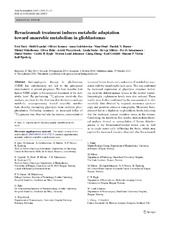| dc.contributor.author | Fack, Fred | en_US |
| dc.contributor.author | Espedal, Heidi | en_US |
| dc.contributor.author | Keunen, Olivier | en_US |
| dc.contributor.author | Golebiewska, Anna | en_US |
| dc.contributor.author | Obad, Nina | en_US |
| dc.contributor.author | Harter, Patrick N. | en_US |
| dc.contributor.author | Mittelbronn, Michel | en_US |
| dc.contributor.author | Bähr, Oliver | en_US |
| dc.contributor.author | Weyerbrock, Astrid | en_US |
| dc.contributor.author | Stuhr, Linda Elin Birkhaug | en_US |
| dc.contributor.author | Miletic, Hrvoje | en_US |
| dc.contributor.author | Sakariassen, Per Øystein | en_US |
| dc.contributor.author | Stieber, Daniel | en_US |
| dc.contributor.author | Rygh, Cecilie Brekke | en_US |
| dc.contributor.author | Lund-Johansen, Morten | en_US |
| dc.contributor.author | Zheng, Liang | en_US |
| dc.contributor.author | Gottlieb, Eyal | en_US |
| dc.contributor.author | Niclou, Simone P. | en_US |
| dc.contributor.author | Bjerkvig, Rolf | en_US |
| dc.date.accessioned | 2015-02-27T13:27:47Z | |
| dc.date.available | 2015-02-27T13:27:47Z | |
| dc.date.issued | 2015-01 | eng |
| dc.identifier.issn | 0001-6322 | |
| dc.identifier.issn | 1432-0533 | |
| dc.identifier.uri | https://hdl.handle.net/1956/9446 | |
| dc.description.abstract | Anti-angiogenic therapy in glioblastoma (GBM) has unfortunately not led to the anticipated improvement in patient prognosis. We here describe how human GBM adapts to bevacizumab treatment at the metabolic level. By performing 13C6-glucose metabolic flux analysis, we show for the first time that the tumors undergo metabolic re-programming toward anaerobic metabolism, thereby uncoupling glycolysis from oxidative phosphorylation. Following treatment, an increased influx of 13C6-glucose was observed into the tumors, concomitant to increased lactate levels and a reduction of metabolites associated with the tricarboxylic acid cycle. This was confirmed by increased expression of glycolytic enzymes including pyruvate dehydrogenase kinase in the treated tumors. Interestingly, l-glutamine levels were also reduced. These results were further confirmed by the assessment of in vivo metabolic data obtained by magnetic resonance spectroscopy and positron emission tomography. Moreover, bevacizumab led to a depletion in glutathione levels indicating that the treatment caused oxidative stress in the tumors. Confirming the metabolic flux results, immunohistochemical analysis showed an up-regulation of lactate dehydrogenase in the bevacizumab-treated tumor core as well as in single tumor cells infiltrating the brain, which may explain the increased invasion observed after bevacizumab treatment. These observations were further validated in a panel of eight human GBM patients in which paired biopsy samples were obtained before and after bevacizumab treatment. Importantly, we show that the GBM adaptation to bevacizumab therapy is not mediated by clonal selection mechanisms, but represents an adaptive response to therapy. | en_US |
| dc.language.iso | eng | eng |
| dc.publisher | Springer | eng |
| dc.relation.ispartof | <a href="http://hdl.handle.net/1956/9447" target="blank">Multimodal Imaging of Physiologic Changes Induced by Anti-Angiogenic Therapy in Glioblastoma</a> | eng |
| dc.rights | Attribution CC BY | eng |
| dc.rights.uri | http://creativecommons.org/licenses/by/3.0/ | eng |
| dc.subject | Glioblastoma | eng |
| dc.subject | bevacizumab | eng |
| dc.subject | Metabolism | eng |
| dc.subject | Adaptation | eng |
| dc.title | Bevacizumab treatment induces metabolic adaptation toward anaerobic metabolism in glioblastomas | en_US |
| dc.type | Peer reviewed | |
| dc.type | Journal article | |
| dc.description.version | publishedVersion | en_US |
| dc.rights.holder | Copyright The Author(s) 2014. | |
| dc.identifier.doi | https://doi.org/10.1007/s00401-014-1352-5 | |
| dc.source.journal | Acta Neuropathologica | |
| dc.source.40 | 129 | |
| dc.source.14 | 1 | |
| dc.source.pagenumber | 115-131 | |

